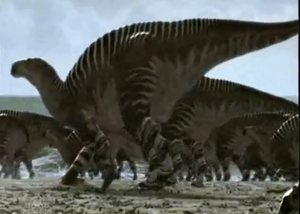
Iguanodon lived:145 to 100 million years ago in the Early to Mid Cretaceous period.
| Name:
Pronunciation: Meaning: Animal Type: Dietary Type: Size: Weight: Major Fossil Finds: |
Iguanodon Ig-WAN-oh-DON Iguana tooth Dinosaur (ornithopod) Herbivore Up to 10 metres long Up to 5 tonnes Europe, and possibly North America and China |
Evidence Remains of Iguanodon and closely related species have been found throughout the world. They were a fantastically successful group of dinosaurs. One particularly rich find was of 30 skeletons in a Belgian coal mine.
The footprints of these kinds of animal are common and show that it usually walked on all fours. It is thought to have had thick column-like back legs, and thinner, lighter front ones. It could rear up onto it's two back legs in order to escape from predators, and to use its hands to gather food. Its middle three fingers were bound together by a plump pad of skin, while its little finger could be curled over to grasp food. Its thumb had a vicious defensive spike.
Iguanodon was a big herbivore, the largest species growing to about 9 metres. It had a turtle-like horny beak at the front of its mouth which was ideal for cropping vegetation. At the back of its jaws numerous teeth were arranged in parallel rows. It was one of the first known dinosaurs to be able to chew. It had a hinged upper jaw, that was able to flex from side to side. This meant that its upper teeth could grind over the lower ones as it bit down hard. Reptiles generally cannot chew their food like mammals because they don't have the special muscles to move their lower jaw from side to side. Iguanodon was no exception, but with its hinged jaw it still managed to chew very effectively in its own unique way.